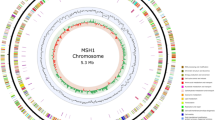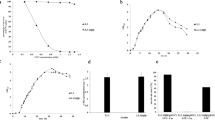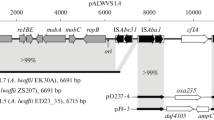Abstract
An Alcaligenes sp. BR60, isolated from surface runoff waters of the Hyde Park industrial landfill, contained a novel 85 kb catabolic plasmid (pBR60) functional in 3-chlorobenzoate (3Cba) degradation. The plasmid exhibited a spontaneous 3.2% frequency of deletion of a 14 kb fragment specifying 3Cba degradation. The deletion mutant BR40 and mitomycin C cured strains were not able to grow on 3Cba and had reversion frequencies of less than 10-10 cell-1 generation-1. Transformation or conjugation of pBR60 into cured strains restored catabolic activity. An EcoRI, BgIII, HindIII and SaII restriction map of the deletion region was constructed, and EcoRI and HindIII fragments spanning the deletion region of the plasmid were cloned in pUC18. Conjugation of resistance plasmid R 68.45 into Alcaligenes sp. BR60, with selection on antibiotics, resulted in the elimination of pBR60 and maintenance of unaltered R68.45. In 30% of the exconjugants, 3Cba degradative capacity was retained, although variation in the regulation of 3Cba degradation was observed in these strains. Hybridization of deletion region fragments to BgIII digested total DNA of BR60 and the R68.45 cured exconjugants revealed the presence of pBR60 deletion region sequences in the chromosome of exconjugants. Hybridization also revealed a repeated sequence flanking the deletion region of pBR60. Selection on 4-chlorobenzoate as a sole source of carbon and energy resulted in the isolation of 4Cba+ mutants of Alcaligenes sp. BR60.
Similar content being viewed by others
Abbreviations
- 3 and 4 Cba:
-
chlorobenzoic acid isomers and growth phenotypes
- HPLC:
-
high pressure liquid chromatography
- ATCC:
-
American Type Culture Collection
References
Arnow LE (1937) Colorimetric determination of the components of 3,4-dihydroxyphenylalanine-tyrosine mixtures. J Biol Chem 118:531–541
Berry D, Kropinski AM (1986) Effect of lipopolysaccharide mutations and temperature on plasmid transformation efficiency in Pseudomonas aeruginosa. Can J Microbiol 32:436–438
Birnboim HC, Doly J (1979) A rapid alkaline extraction procedure for screening recombinant DNA. Nucl Acids Res 7:1513–1523
Chatterjee DK, Chakrabarty AM (1982) Genetic rearrangements in plasmids specifying total degradation of chlorinated benzoic acids. Mol Gen Genet 188:279–285
Chatterjee DK, Chakrabarty AM (1983) Genetic homology between independently isolated chlorobenzoate-degradative plasmids. J Bacteriol 153:532–534
Chatterjee DK, Chakrabarty AM (1984) Restriction mapping of a chlorobenzoate degradative plasmid and molecular cloning of the degradative genes. Gene 27:173–181
Crosa JH, Falkow S (1981) Plasmids. In: Gerhardt P, Murray RGE, Costilow RN, Nester EW, Wood WA, Krieg NR, Phillips GB (eds) Manual of methods for general bacteriology. Am Soc Microbiol, Washington, DC, pp 269–270
Don RH, Pemberton JM (1981) Properties of six pesticide degradation plasmids isolated from Alcaligenes paradoxus and Alcaligenes eutrophus. J Bacteriol 145:681–686
Don RH, Pemberton JM (1985) Genetic and physical map of the 2,4-dichlorophenoxyacetic acid-degradative plasmid pJP4. J Bacteriol 161:466–468
Dorn E, Knackmuss H-J (1978) Chemical structure and biodegradability of halogenated aromatic compounds. Two catechol-1,2-oxygenases from a 3-chlorobenzoate-grown pseudomonad. Biochem J 174:73–84
Feinberg AP, Vogelstein P (1984) Addendum: A technique for radiolabeling DNA restriction fragments to high specific activity. Anal Biochem 137:266–267
Fulthorpe RR, Straus NA, Wyndham RC (1988) Bacterial adaptation to chlorobenzoate contamination in the Niagara region investigated by DNA:DNA colony hybridization. Am Soc Testing Materials Spec Tech Publ (in press)
Furukawa K, Chakrabarty AM (1982) Involvement of plasmids in total degradation of chlorinated biphenyl. Appl Environ Microbiol 44:619–626
Ghosal D, You I-S, Chatterjee DK, Chakrabarty AM (1985a) Microbial degradation of halogenated compounds. Science (USA) 228:135–142
Ghosal D, You I-S, Chatterjee DK, Chakrabarty AM (1985b) Genes specifying degradation of 3-chlorobenzoic acid in plasmids pAC27 and pJP4. Proc Natl Acad Sci USA 82:1638–1642
Hanahan D (1984) Techniques for transformation of E. coli. In: Glover DM (ed) DNA cloning, vol I, A practical approach. IRL Press, Washington DC 115
Latorre J, Reineke W, Knackmuss H-J (1984) Microbial metabolism of chloroanilines: enhanced evolution by natural genetic exchange. Arch Microbiol 140:159–165
Maniatis T, Fritsch EF, Sambrook J (1982) Molecular cloning: A laboratory manual. Cold Spring Harbor Laboratory, Cold Spring Harbor, N.Y.
Meulien P, Downing RG, Broda P (1981) Excision of the 40 kb segment of the TOL plasmid from Pseudomonas putida mt-2 involves direct repeats. Mol Gen Genet 184:97–101
Micard D, Sobrier ML, Couderc JL, Dastugue B (1985) Purification of RNA-free plasmid DNA using alkaline extraction followed by Ultrogel A2 column chromatography. Anal Biochem 148:121–126
Nakazawa T, Inouye S, Nakazawa A (1980) Physical and functional mapping of RP4-TOL plasmid recombinants: analysis of insertion and deletion mutants. J Bacteriol 144:223–231
Pettigrew CA, Sayler GS (1986) The use of DNA:DNA colony hybridization in the rapid isolation of 4-chlorobiphenyl degradative bacterial phenotypes. J Microbiol Meth 5:205–213
Reineke W, Knackmuss H-J (1980) Hybrid pathway for chlorobenzoate metabolism in Pseudomonas sp. B13 derivatives. J Bacteriol 142:467–473
Riess G, Holloway BW, Pühler A (1980) R68.45, a plasmid with chromosome mobilizing ability (Cma) carries a tandem duplication. Genet Res 36:99–109
Schwien U, Schmidt E (1982) Improved degradation of monochlorophenols by a constructed strain. Appl Environ Microbiol 44:33–39
Scordilis GE, Ree H, Lessie TG (1982) Identification of transposable elements which activate gene expression in Pseudomonas cepacia. J Bacteriol 169:8–13
Sinclair MI, Maxwell PC, Lyon BR, Holloway BW (1986) Chromosomal location of TOL plasmid DNA in Pseudomonas putida. J Bacteriol 168:1302–1308
Slater JH, Weightman AJ, Hall BG (1985) Dehalogenase genes of Pseudomonas putida PP3 are on chromosomally located transposable elements. Mol Biol Evol 2:557–567
Southern EM (1975) Detection of specific sequences among DNA fragments separated by gel electrophoresis. J Mol Biol 98:503–517
Weisshaar M-M, Franklin FCH, Reineke W (1987) Molecular cloning and expression of the 3-chlorobenzoate degrading genes from Pseudomonas sp. B13. J Bacteriol 169:394–402
Wyndham RC (1986) Evolved aniline catabolism in Acinetobacter calcoaceticus during continuous culture of river water. Appl Environ Microbiol 51:781–789
Wyndham RC, Straus NA (1988) Chlorobenzoate catabolism and interactions between Alcaligenes and Pseudomonas species from Bloody Run Creek. Arch Microbiol 150:230–236
Yannisch-Perron C, Vieira J, Messing J (1985) Improved M13 phage cloning vectors and host strains: nucleotide sequences of the M13 mp 18 and pUC 19 vectors. Gene 33:103–119
Author information
Authors and Affiliations
Rights and permissions
About this article
Cite this article
Wyndham, R.C., Singh, R.K. & Straus, N.A. Catabolic instability, plasmid gene deletion and recombination in Alcaligenes sp. BR60. Arch. Microbiol. 150, 237–243 (1988). https://doi.org/10.1007/BF00407786
Received:
Accepted:
Issue Date:
DOI: https://doi.org/10.1007/BF00407786




